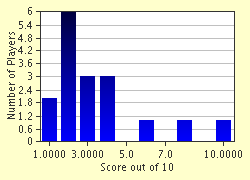Quiz Answer Key and Fun Facts
1. Which of these is considered to be the earliest known piece of Spanish literature?
2. Which of these is an example of the form known as "Mester de Juglaría"?
3. When did the Castilian narrative poetry known as "Mester de Clerecía" begin to be written?
4. What literary work ended the era of the "Mester de Clerecía", and marked the beginning of the Spanish Renaissance?
5. Which is a distinguished author of the Spanish Renaissance?
6. What novel do scholars identify as starting the picaresque genre during the Spanish Golden Age?
7. During the Spanish Golden Age, who modified the Classical theater to create a new style?
8. Which text introduced the legendary Don Juan Tenorio to International literature?
9. Which of the following wrote "La Araucana"?
10. Who was the main exponent of the "Conceptismo" movement during the Baroque Period?
Source: Author
GoldenDesert
This quiz was reviewed by FunTrivia editor
looney_tunes before going online.
Any errors found in FunTrivia content are routinely corrected through our feedback system.


